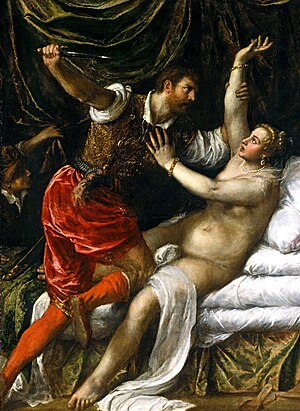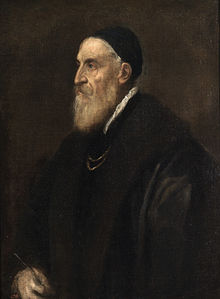Tarquinius and Lucretia

|
| Tarquinius and Lucretia |
|---|
| Titian , 1568 to 1571 |
| Oil on canvas |
| 189 × 145 cm |
| Fitzwilliam Museum |
Tarquinius and Lucretia ( it. : Tarquinio Lucrezia e ) is a painting by the Italian painter Tiziano . The painting was created between 1568 and 1571. At that time, Titian was around 80 years old. Today the painting by Titian is in the Fitzwilliam Museum at Cambridge University in Cambridge , England .
Interpretation and consideration
The picture shows Tarquinius' attack on Lucretia . The dagger in Tarquinius' right hand is a little lighter than the rest of the picture. Titian was very clever in depicting a dramatic movement in the picture. The feeling of movement comes into the picture through the swimming of the green curtain in the background.
Tarquinius appears entirely in red: reddish hair, reddish beard, red stripes on his sash, red shirt, purple trousers and scarlet legs. Even the shadow looks reddish. However, his white eyes stand out from the face, which is otherwise darkened by shadows. He fixes Lucretia's face. Through this choice of color Tizian shows and symbolizes Tarquinius' excitement and aggressiveness , but he also condemns him at the same time.
The boy on the left symbolizes the powerlessness against this crime. But he is also a witness to the crime and at the same time a voyeur. The viewer sees himself involved in the crime and has to wonder if Lucretia could not be helped.
Tarquinius' posture is chosen with care. Most of his weight is on the right knee, which is between Lucretia's legs. The left foot only touches the ground very lightly. Titian changed his arm position several times because it never suited him.
After he had completed the picture, he wrote to his friend Philipp, for whom the painting was also intended, that he was enthusiastic about the picture.
backgrounds
Excerpt from Publius Ovidius Nasos Fasti : (freely translated)
The Roman prince Tarquinius (son of Tarquinius Superbus ) comes into the house, is greeted warmly and has dinner with the hosts. Then everyone goes to bed, but Tarquinius gets up again. He goes to Lucretia (wife of Lucius Tarquinius Collatinus ). He takes his dagger and said to her: “I have a dagger with me, Lucretia. It is I, Tarquinius, the king's son, who speaks to you. ” She could neither speak nor think and is rigid with fear. What should she do? Fight? He touches her breasts and thus takes her life out of shame. But the girl overcomes her fear and says: “This victory will destroy you. What this one night will cost you and your kingdom. "
After the rape, she told her husband and father everything and committed suicide because she could not bear the shame. The two men swore to find Tarquinius and kill him. The Roman citizens killed Tarquin and overthrew the king. Then they proclaimed the republic. (see Roman Republic ) Lucius Tarquinius Collatinus and Lucius Junius Brutus become the first consuls of the young republic.
Lucretia became a female model of virtue and a martyr . Lucretia's rape and suicide have often been depicted.
More artists
- Luca Giordano - Lucrezia e Tarquinio
- Jacopo Palma - Il Giovane Tarquinio e Lucrezia
- Antonio Bellucci - Tarquinio e Lucrezia
- Peter Paul Rubens - Tarquinius and Lucretia
- Giovanni Battista Tiepolo - Tarquinius and Lucretia
- Hans von Aachen - Tarquinius and Lucretia
- Jan Massys - Tarquin et Lucrèce
- Charles-Alphonse Du Fresnoy - Lucretia's Death
There is also a poem by William Shakespeare , The Rape of Lucrece, on the subject .
literature
- Kaminski, Marion: Tiziano Vecellio, called Tizian . Könemann Verlag, Cologne 1998. ISBN 3-8290-0699-3
Web links
- Everything about Lucretia (English) ( Memento from February 2, 2002 in the Internet Archive )
- Kunsthistorisches Museum about the picture (PDF) (page 11)
- Lucretia's Rape Story
